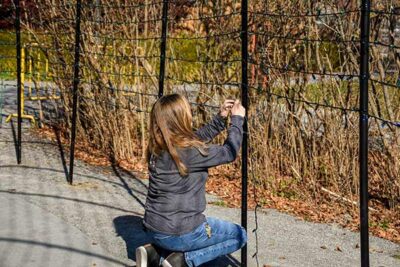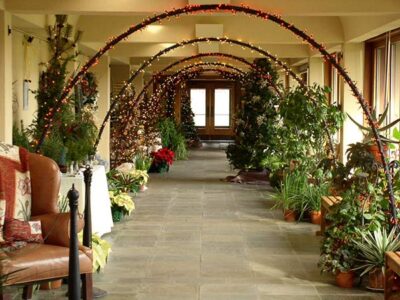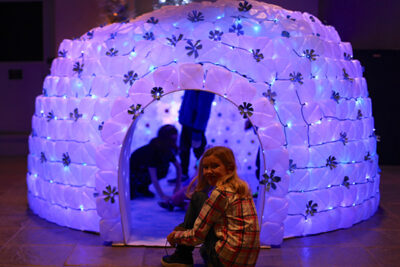By Gitu Jain, New England Botanic Garden
November 2024
Since it first illuminated the Garden’s landscape years ago, Night Lights has become a cherished tradition, drawing thousands of visitors annually. Beyond highlighting the Garden’s natural beauty, the annual winter light display invites people to celebrate the magic and festivities of the season. Last year alone, the Garden welcomed 66,000 guests to experience the sparkle while creating unforgettable memories.
But Night Lights wasn’t always the signature event it is today. Dawn Davies, NEBG’s formal gardens manager, has worked here for 25 years and has seen the remarkable ways Night Lights has evolved over the years firsthand. “It’s been a delight to see how the event and the displays have grown over the years,” she says. “Seeing how Night Lights welcomes more visitors to the Garden each year and fosters connection with nature has been a joy.”
So, what were those early days like?
In the mid-nineties, the Garden hosted an annual event that some will remember called the ‘Festival of Trees,’ showcasing Christmas trees decorated with ornaments. Then in 1997, the Garden introduced a year-end light display known as Holly Days to raise funds for its operations. The event ran through 2013, mainly during the day and mostly indoors with some outdoor evening experiences included. At that time, light displays were not the focus but rather part of the overall Holly Days celebrations, which included live music, performances, and various holiday activities. The real highlight of Holly Days was handcrafted ornaments made with natural materials such as dried flowers, leaves, seeds, cones, and branches, as well as other festive decor that captured the spirit of the holidays. Most years adopted a unique theme.
Take 2011, for instance. Holly Days: Fashioned from Nature featured ornaments that highlighted the year’s glitz and glamour, whereas 2012’s Holly Days: Food, Glorious Food, showcased ornaments crafted to look like sugarplums and cupcakes alongside other faux culinary decorations. As part of Holly Days, the Garden collaborated with outside organizations, such as garden clubs, to decorate trees, wreaths, and other holiday decor. Some years, the Garden also held People’s Choice awards for the decorations.
In 2014, Holly Days transformed into Winter Reimagined, emphasizing a more significant celebration of holiday lights. The outdoor formal gardens were decked out for the season, and the Garden expanded its evening hours to allow more visitors to enjoy the reimagined experience. New features were introduced, including s’mores roasting by the fire, an activity beloved by the young and young at heart. Staff and volunteers created unique displays, such as the bromeliad tree display and the whimsical milk jug igloo—all adding a touch of magic to the experience. These changes led to a growth in visitation, increasing from 6,800 people in 2013 to 16,000 in 2014.
In response to the growing interest, the Garden’s signature event transformed again, and in 2018, it became Night Lights. This bigger and brighter celebration of the winter season drew even more people of all ages and backgrounds, increasing the visitation to 39,000 people, up from 25,000 in 2017. The light displays expanded in scale and artistry, highlighting the beautiful plant forms and immersive spaces found throughout the gardens and growing to be even more mesmerizing than before. Each year, the experience continues to bring the magic with one-of-a-kind new themes. For instance, in 2022, Night Lights immersed visitors in different environments on Earth, from icy mountaintops to meadows of pollinators and even into the sea, whereas 2023’s displays took guests on an exploration through the cosmos and back. The imagination staff bring to each year’s displays ensures that Night Lights offers something unique for new visitors and returning visitors alike.
This year, visitors will be dazzled by a kaleidoscope of colors at Night Lights: Color Cascade as they walk through the formal gardens, decorated indoor areas, and conservatories. And they’ll be in for more than a visual feast; Night Lights today is an experience that delights all senses and is like no other. Imagine strolling through a display of a quarter million twinkling lights while indulging in seasonal treats like s’mores around cozy fire pits with family and friends. Or sipping warm beverages while sharing a laugh and capturing memories with fun photo opportunities scattered throughout the Garden. And the fun doesn’t stop there — guests can enjoy holiday shopping or glide to their heart’s content on the new outdoor skating rink.

Dawn Davies, formal gardens manager at NEBG, strings lights for the iconic Rainbow Tunnel, a feature of 2024’s Night Lights: Color Cascade.
Pulling off this spectacular celebration requires dedication from both staff and volunteers. The team works tirelessly to design and install the displays with planning beginning as early as February. As September arrives, volunteers help staff bring the Night Lights vision to life, donating more than 300 hours of time to crafting and stringing lights. This shared effort culminates in the joy Night Lights brings to all who visit. The impact extends even further as funds raised through Night Lights support our nonprofit Garden’s four-season operations and our mission to connect people with plants.
About the Author
Gitu Jain is New England Botanic Garden’s Senior Marketing and Communications Manager. She oversees the Garden’s marketing and communications strategy, initiatives, and campaigns to promote brand visibility, reputation, and reach on national, regional, and local levels.


